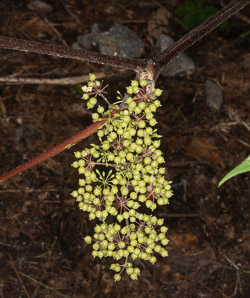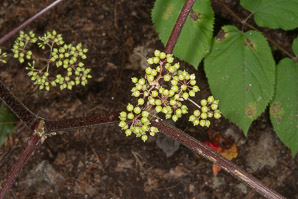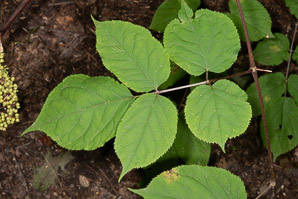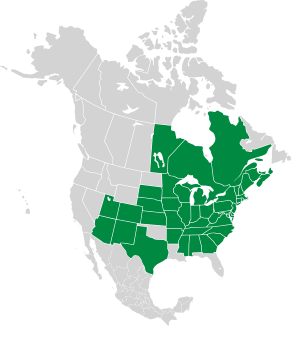
|
Aralia racemosa L. American spikenard, small spikenard, Indian root, spice berry, spignet, life-of-man, petty morel
American spikenard is native to much of eastern North America. When I first encountered this plant, the mass of unripe whitish berries clustered at branch nodes made me immediately think of poison ivy. Had I crossed paths with it a couple of weeks later, though, I’d have seen the berries turn ruby, then purplish, red. Poison ivy berries remain a waxy white color. Plants: 3-5′ (91-152 cm) in height and width. Roots are aromatic. Leaves: Large compound leaves have three main sections, each further divided into 9 to 21 ovate, stalked, leaflets, with heart-shaped bases. Leaflets are 1¾-6″ (5-15 cm) long. Flowers: Large racemes consist of branched clusters of smaller clusters of flowers. Flowers are greenish-white, star-shaped, ⅛″ (3.2 mm) in size, with white stamens. Flower stalks have short white hairs, giving them a frosted appearance. Flowers appear from June to August. To a gardener, the flowers are underwhelming, but up close they look pretty cool. Fruits: Dense clusters of berries up to ¼″ (6.3 mm) in size turn a deep reddish purple. They ripen in September. Edibility: Ripe berries are edible. They taste good and can be used to make jam. Online References:
Plantfinder.nativeplanttrust.org References:
Aralia racemosa description by Thomas H. Kent, last updated 3 Sep 2023. © FloraFinder.org. All rights reserved. |
Unripe berries. · 8/31/2023 · Rines Forest, Cumblerland, Maine · ≈ 6 × 10″ (16 × 24 cm) Unripe berries. · 8/31/2023 · Rines Forest, Cumblerland, Maine · ≈ 10 × 6″ (24 × 16 cm) 8/31/2023 · Rines Forest, Cumblerland, Maine · ≈ 12 × 8″ (31 × 20 cm) Range:
|





